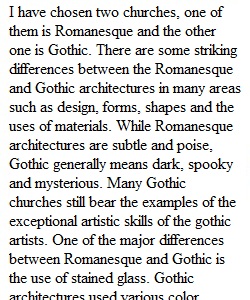


Q This discussion will focus upon comparing Romanesque and Gothic styles. To start this discussion, State University of New York at Albany's Dr. Strum has created a virtual tour of the Cloisters, a branch of the Metropolitan Museum in New York City that is dedicated to medieval art and architecture. From the textbook or online sources, choose a pair of sculptures, manuscript illuminations, or church architectural details to research and compare. (If you look for your artworks online, it might be helpful to search by subject matter, as well as period.) One work should be Romanesque, and one should be Gothic. The Gothic style continued into the 14th century, so examples from this time period are appropriate. If you can find similar subjects, such as two standing figures, two Last Judgments, or two Annunciations, so much the better for ease of comparison. If you choose church details, consider two towers, two views of vaulting, or two views of side walls, one from a Romanesque church and one from a Gothic church. As you research and analyze your works, keep the following in mind: • Consider the original purpose served by each of your artworks (if known). • Consider the iconography. Is there symbolism that may not be readily apparent? Is a story being told? Please explain. • For architecture, consider the forms used. Romanesque refers to the use of older Roman forms. How did these forms and engineering change during the Gothic period? • Expressive exaggeration is characteristic of medieval art, especially in Romanesque art. How is your work expressive? Compare the treatment of figures, drapery, facial features, and spatial arrangement. • Does naturalism or evidence of worldly observation on the part of the artist show at all? If yes or no, please explain. Begin your first post, 250 words minimum, by introducing the works, providing their titles, their locations, and the date and medium for each. Explain first the similarities of the subject, style, or church structure. What do the works have in common? This question may be answered by describing subject matter of the artworks or placement of the architectural features. Are there stylistic similarities? Remember to provide explanations. In a second paragraph, describe the differences, especially in terms of stylistic differences. Try to find the most appropriate descriptive words to express what you see. Note specific details to help guide your classmates to what you observe in each artwork. Specific details help back up your more general style observations. Be sure to include images or links to images for your classmates to view. Read others’ postings to get a full picture of Romanesque and Gothic styles. Post a one paragraph response to at least two classmates with your own observations or gained insights into specific works or medieval art in general. Remember, do not parrot your peer’s response. Are there general conclusions that can be drawn regarding style changes in medieval art?
View Related Questions